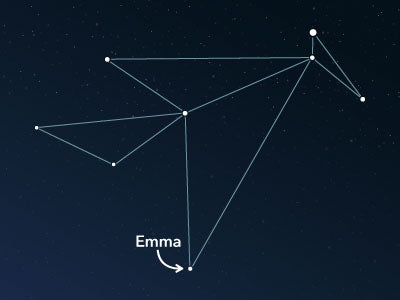The constellation Phoenix
Características
- Nombre latino
- Phoenix
- Hemisferio
- Hemisferio sur
- Visibilidad
- September - November
- Área
- 469 deg²
- Estrella más brillante
- Ankaa (HIP number 2081)
- Especialidades
- Galaxies

The Phoenix is associated with a mythological immortal bird. It is an inconspicuous constellation in the southern hemisphere and was introduced by Dutch sailors at the end of the 16th century. There are only a few deep-sky objects located within its area.
Hemisphere, visibility, and area
The Phoenix constellation lies in the southern celestial sky and is visible between 32° N and 80° S. 32° northern latitude corresponds to places such as Marrakesh in Morocco or Savannah in the United States. Thus, it can not be observed in Central Europe or Canada. 80° southern latitude means it can be seen in parts of Antarctica.
The best time to observe the constellation is during the months of September, October, and November. The Phoenix stretches over the night sky with an area of about 469 square degrees, making it the 37th largest constellation out of all 88.
In star charts, the constellation is either depicted as a simple triangle or visualized as a composition of multiple triangles using a multitude of stars.
The brightest star, Ankaa (Latin: α Phoenicis, Alpha Phoenicis), always marks the northern point. It is a double-star system with an apparent magnitude of roughly 2.4 and is located at a distance of approximately 85 light-years from earth.
The other stars in the Phoenix are not particularly bright, making it challenging to locate the constellation in the night sky. When searching for it, the neighboring constellations can provide a good reference point. To the north, it borders the Fornax and the Sculptor. To the east, it is adjacent to the Grus. To the west and south, it borders the great river Eridanus and the Tucana. Additionally, the Hydrus is located to the southwest.
Specialties in the constellation
The Scottish astronomer James Dunlop discovered the two barred spiral galaxies NGC 625 and NGC 7689 in the area of Phoenix in September 1826.
NGC 625 has a visual magnitude of about 11.1. Its distance to the Milky Way is estimated to be around 14 million light-years.
NGC 7689 is similarly faint with an apparent brightness of about 11.5. However, it is significantly farther away from the Milky Way at around 85 million light-years.
History and mythology
At the end of the 16th century, a fleet of Dutch ships first traveled to the legendary Spice Islands (now Indonesia). The primary goal was to establish new trade relations, but for the long journey, the crew was given an additional task. The cartographer Peter Plancius commissioned the navigator Pieter Dirkszoon Keyser to measure the positions of stars in the southern sky.
In the process, they collected data from around 135 stars and subsequently defined twelve new constellations. Among them was "Den Voghel Fenicx," which was later included in the new celestial atlas under the name Phoenix.
The bird Phoenix originates from ancient Egyptian mythology. Here, it was considered a personification of the sun god and the first bird of creation. According to later legends, it is said to have lived for over 500 years and became a symbol of resurrection. When it was close to death, it is said to have always built a nest in which it burst into flames. The next morning, a young, new bird Phoenix emerged from its ashes.
PublicadoLeer más artículos interesantes

An overview of all 88 constellations
Learn more about all 88 constellations and read interesting information about the mythology, visibility, and features.

Planetario App
¡Descubre el cielo nocturno con nuestra aplicación de planetario!
Disponible para iOS y Android.

Nombrar una estrella en una constelación
Name a star in a constellation and create something that lasts for eternity.